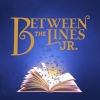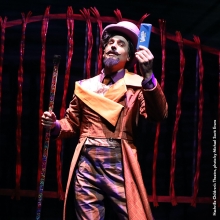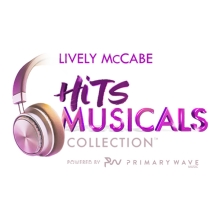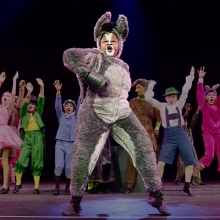Filichia Features: Project, Please!
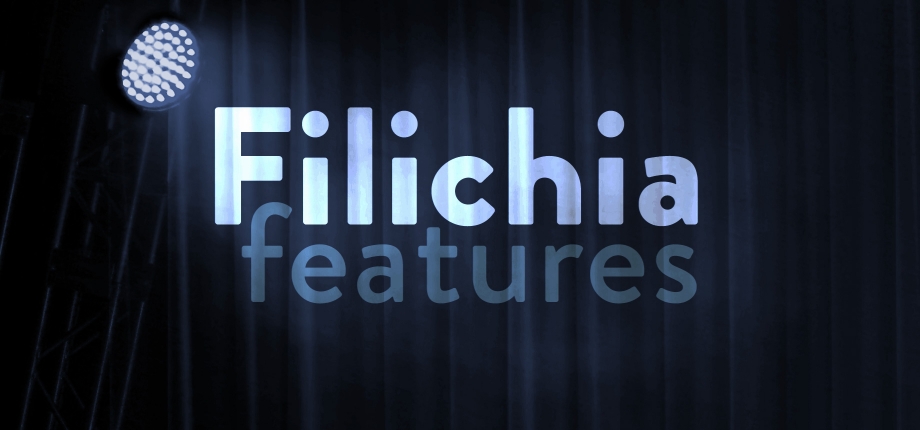
Filichia Features: Project, Please!
You've seen it hundreds of times in films.
Why don't we see it more often on stage?
Many a movie begins with a graphic that defines time and place Cabaret starts with the notation that it's "1931 Berlin." Life with Father, which has been the longest-running Broadway non-musical for more than 70 years, has its film begin with the words "New York, 1883."
Stage shows usually rely on Playbills (or reasonable facsimiles thereof) to establish Time and Place. But many recent shows haven't even bothered to list them.
Playbills that do establish "Time" and "Place" may still not be getting their messages across to all theatergoers. Many attendees take their Playbills from the usher, get seated and instead of looking at the magazine to learn about the show, what do they do?
Text.
Eat.
Guzzle.
So when the curtain goes up, these theatergoers don't immediately know what era or year they're experiencing.
One could say "That's their own fault," but that's another issue. Instead of placing blame, you directors who have access to projections should use them right at the top of your show to define the When and the Where.
This isn't a new idea. Les Miserables has projected its various Times and Places since Preview One. No, it's not the main reason why it's still London's longest-running show. But giving theatergoers their bearings has to have helped.
So don't lose the opportunity to inform your audience, too - especially when you're doing Sunday in the Park with George. Your theatergoers may infer that Act Two is happening here and now … until they start thinking "Wait - Marie is the grand-daughter of George and Dot? But didn't that first act take place in the 1800s? By now, she'd have to have died."
True - but in 1984, that Dot was still alive was plausible. So as the replication of Seurat's famous painting is giving way to the Chromolume - which in itself can confuse theatergoers - project "1984: An art museum" on your back wall.
One could argue "You don't need to do that because costumes can establish Time and Place." Sure - but in the case of Sunday in the Park (among plenty of other late 20th century musicals), fashions haven't changed dramatically enough that theatergoers would immediately assume that what the characters are wearing signals 1984.
Similarly speaking, Mamma Mia! deals with Donna and the Dynamos, a '70s singing group. Now do the math: Donna could have been as young as 20 when the group was formed, but even if so, she'd now be pushing 70. Would she have a daughter who's just leaving her teen years? Probably not.
So in addition to adding "Place: Skopelos, a Greek island," include "1999" -- the year which was "Time: Now" when the mammoth hit opened in London.
Assassins could also benefit from projections, ranging from Lincoln's assassination on "April 14, 1865; Ford's Theatre, Washington, D.C." to "September, 1975; California" - the month and locale of two assassination attempts against President Gerald R. Ford.
Because Lynette "Squeaky" Fromme tried to shoot Ford on the 7th of that month in Sacramento and Sara Jane Moore made her attempt 17 days later in San Francisco - and both appear in the same pair of scenes - a projection of the month and state will suffice. Still, this projection puts matters in historical context, which is always appreciated.
Roosevelt is the subject of an Assassins song but he's not the same Roosevelt who's seen at the end of Newsies. Franklin's in the former musical and Theodore, his fifth cousin, has a cameo in the latter. Both have been off the public radar for so long that some theatergoers may not know one from the other. Projecting that the FDR scene in Assassins occurs in "1934; Miami" may help, as will "1899; New York City" over which Governor Theodore Roosevelt presides.
True, many shows create a Time and Place of their own: Disney's Beauty and the Beast, Into the Woods, Seussical, and Shrek are various forms of fairy tales that don't need much identification. Yet another fairy tale - and that's what Finian's Rainbow JR. is -- can get your audience to laugh as soon as the show starts if the projection tells them they're in - yes! -- Missitucky.
Needless to say, for Hairspray you won't need a projection for "Place," what with an opening number called "Good Morning, Baltimore." And for that matter, you won't need one for "Time" for Back to the '80s.
But for most others shows, there's a Time and a Place for everything.
You may e-mail Peter at pfilichia@aol.com. Check out his weekly column each Monday at www.broadwayselect.com and Tuesday at www.masterworksbroadway.com . He can be heard most weeks of the year on www.broadwayradio.com.
Follow the fun @mtishows on Instagram, Facebook, and Twitter.









